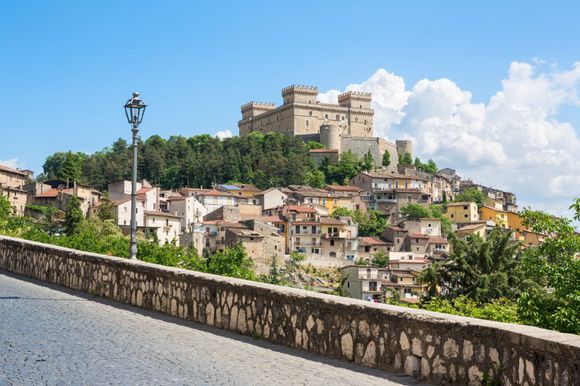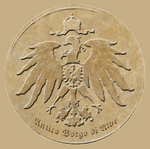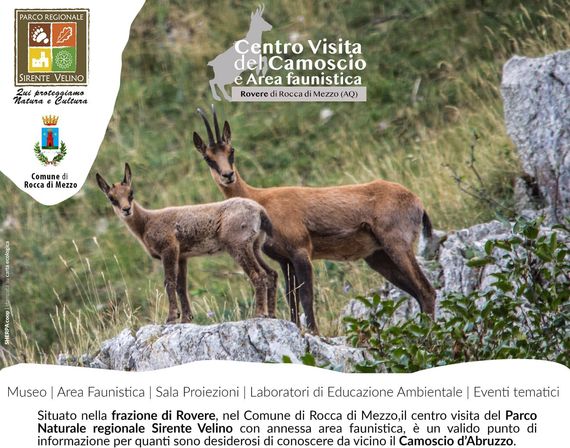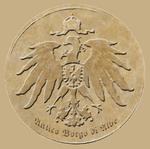Explore the Sirente Velino Natural Park with our excursions
Alba Fucens is an ancient Roman city at the foot of Monte Velino, in the province of L'Aquila, in Abruzzo, and is an archaeological jewel still to be explored. The impressive remains that emerged following excavations that were begun by Fernand De Visscher in 1949, actually continued through the years to follow and have recently been restarted.
- History
Given its strategic position at the intersection of the regions inhabited by the Marsi and the Equi people, the city of Alba was long disputed between the two communities. It became a Roman colony in 303 BC, but only later was it given town status.
Having always been an ally of Rome, the town was defended against Hannibal during the second Punic Wars and remained loyal during the Social War. Having taken Mario's side against Silla, the region was divided up (centuriation) and was given to Silla's veteran lieutenants. The city then became involved in the war between Pompey and Caesar and was therefore used as a fortress for Domizio Enobarbo's anti-Caesarean commanders that later surrendered to Caesar.
During imperial times, the city was a rich area which we can see from archaelogical remains, one of which being the impressive amphitheatre that was bequeathed by Macrone, the city's prefect. To avoid his goods being confiscated, Macrone committed suicide after having been convicted by Caligola. However, beforehand, he had an amphitheatre built in his hometown of Alba Fucens, which he left as his devise.
- Town development
Among the ruins of Alba Fucens that have been brought to light, you can admire the macellum or market, the thermal baths, rich in mosaics with marine depictions, the male and female baths, and the chapel of Hercules.
Designed as a typical Roman fort, the city developed on a Cardo and Decumanus grid. By following along the Decumanus Maximus (Via del Miliario), you will be able to visit the remains of ancient Roman homes, divided into sections with mosaics, dry walls, votives. You can also walk through the peristyle columns that have been reinstated by archaeologists. Pay particular attention to the milestone (miliario) depicting a gladiator fight with an inscription dedicated to Emperor Magnentius and indicates the distance from Rome (68 Roman miles).
In the opposite direction, along the so-called via dei Pilastri (way of Columns), we can find taverns with original floors, with lead piped washbasins and wine bars. The cyclopean walls used to defend the city have been well preserved and comprised of 4 gates and measured a distance of 3 km around the city. We can also find the remains of the public theatre which is located in the "Colle Pettorino", one of the city's three natural foothills. This all helps us imagine the rich cultural life in Ala Fucens which was financed by wealthy merchants at the time.
The underground city was explored for the first time by the Irish archaeologist Dodwell and revealed an efficient sewage system (the cloaca maxima) in polygonal masonary. This is the only example found throughout Italy and is still being studied today by archaeologists and speleologists.
The twelveth century Chiesa di San Pietro (St. Peter's Church) is well worth a visit, as it was partially destroyed during an earthquake in 1915. It was built on the highest hill and is above a pagan crypt that was part of the Temple of Apollo. The Christian church has preserved sculptural evidence such as spiral columns from the partition wall (iconostasis) from the Cosmati school.
The apse of the church is of great value and has been decorated with theriomorphic motifs on the outside.
- What to visit
The amphitheater has excellent acoustics, and is currently used for cultural initiatives, concerts and great Greek and Latin classical theatre performances.
The site is always open and is free of charge unless you would like a guide, then there is a fee. You can admire tombstones, coins, vases, statues and other findings from in and around Alba Fucens in the Chieti and Celano museums.
You can also visit the surrounding region in many directions from the town of Albe, which today is known as Alba Fucens and is part of the town of Massa D'Albe. Towards the north, the massive Monte Velino stands out at 2487 metres high, which is located in the Sirente-Velino natural reserve and is rich in both flora and fauna making a wonderful destination for nature walks, hiking and biking tours. In the nort-east, you will find the town of Magliano de' Marsi. Here, close by the village of Rosciolo, you can find the S.Maria Benedictine church in Valle Porclaneta. This is an architectural treasure where you can marvel at a pulpit attributed to Nicodemus of Guardiagrele, at a ciborium with zoomorfic and phytomorphic motifs as well as some frescoes. Amongst the frescoes the two that stand out are the one that depicts an unusual Madonna, who is nursing and baring her breast, and at the entra nce we can see the imagine of Santa Lucia.
Monte Velino Natural Park
Have fun ... slowly.
Walk slowly, don't rush your exploration and have fun and enjoy yourself at the same time. This way you will find out about the Sirente Velino Park's nature and history in an intense and engaging way. An invitation for anyone interested in visiting the region.
Biking, horseback riding, Nordic walking, hiking, snowshoeing, cross-country skiing, taking part in rural activities, nature watching, in whichever way you decide to enjoy the park, stop and capture nature's smells, sounds and colours, and discover the historical and cultural storylines of ancient and genuine places.
The Park trails
The Sirente Velino Park area has an extensive network of trails which are based on nature, religion or culture and where you will discover and explore the region along a peaceful and pleasant journey.
These trails give us the opportunity to visit all areas of greatest interest, from rural churches inviting us to enjoy peace and serenity, to the charm of the Aterno river which is incredibly important from an environmental viewpoint. See the superb watchtowers, and the plateaus where we can retrace centuries of human history, and enjoy the enchanting mountain landscapes, rich in beech woods.
- Grotti di Stiffe (Stiffe Caves - 695 m)
- The Sirente meadows (1100 m)
- Pescina nature trails
Rules of conduct
- respect the nature that surrounds you
- never leave the path always
- stay in a group and follow the guides' instructions
- avoid smoking so as not to cause the risk of fire
- speak quietly and don't make too much noise: listen to the sounds of nature
- always leave the area as you would like to find it
- please carry suitable topographic maps (Park maps, IGM Military Geographic Institute - CAI - etc.)
Ovindoli Monte Magnola
There are excellent ski resorts and facilities located at the centre of the park for all those who love winter sports. Ovindoli also offers visitors good accommodation and alpine ski slopes of all levels of difficulty. It is also part of the Ski Parks ski pass, together with Campo Felice, Campo Imperatore and Grotte di Stiffe.
On the Altopiano delle Rocche - "Piani di Pezza" (in the Rocca di Mezzo region), there are Nordic ski slopes, which are among the longest in the centre-south and where there was the historic meeting in 1986 between Pope John Paul II and 13,000 young AGESCI scouts.
In the village, you can find facilities equipped for all other kinds of sport, especially horse riding, mountaineering, hiking, paragliding, archery and free climbing.

Slide title
Scrivi qui la tua didascaliaButton

Slide title
Scrivi qui la tua didascaliaButton
Piccolomini Castle in Celano
The Piccolomini castle in Celano is protected by a mighty wall, marked by walkways and ramparts. It majestically and imposingly overlooks the Fucino plain which once-upon-a-time was a lake.
Belonging to the fortified residence, it is made up of a central block which has a perfectly symmetrical, rectangular shape and four corner towers with battlements reflecting the points of the compass.
- Learn more
Built as a military fortress at the end of the 14th century, by order of Count Pietro Berardi, it was later enlarged by his niece Covella with her husband Leonello Acclozamora. It was finally completed and transformed into a residential palace by Antonio Todeschini Piccolomini, nephew of Pope Pius II, after his inauguration as Count in 1463 by Ferrante D'Aragona, sovereign of Naples. Other noble families alternated over the centuries, until they became state property in 1938.
After the disasterous earthquake on 13 January 1915, the building, although solid, suffered serious and considerable damage. The building was then abandoned for many years which brought more damage. The Italian state then seized the property (expropriation) and began renovation work in 1940 which, having been suspended due to the second world war, was only finished in 1960. Work was carried out following the original plans, reusing and reassembling any materials that were salvaged.
It can been seen for many miles around throughout the Fucino area, the castle has been home to the Museo Nazionale d'Arte Sacra della Marsica (National Museum for Religous Art in Marsica) since 1992.
The museum tour extends on one floor through 8 different exhabition rooms, divided into themed sections: sculptures (stone and wood), paintings (murals, canvases and panels) as well as jewellery. The beautiful works of art orginate from all over the Marsican region and date back to between the 6th and 18th centuries.
We must point out the two carved wooden doors, created in the 12th century, the precious triptych from Alba Fucens with very fine miniatures and the Orsini cross dated 1334.
The castle also houses an archaeological section dedicated to the Torlonia Collection, consisting of finds found during the drainage of Lake Fucino. Of particular importance and beauty is the limestone relief of the 2nd century A.D. with a view of the city and its territory.
Since the earthquake of April 6, 2009, which hit the city of L'Aquila hard, the Marsican Museum Pole houses works of great artistic value from the National Museum of Abruzzo.
The museum also has a conference room, rooms for temporary exhibitions, outdoor spaces for musical and theatrical performances and rooms for educational workshops. A new educational space for children has recently been inaugurated and the Castle's prisons have been opened to the public.











